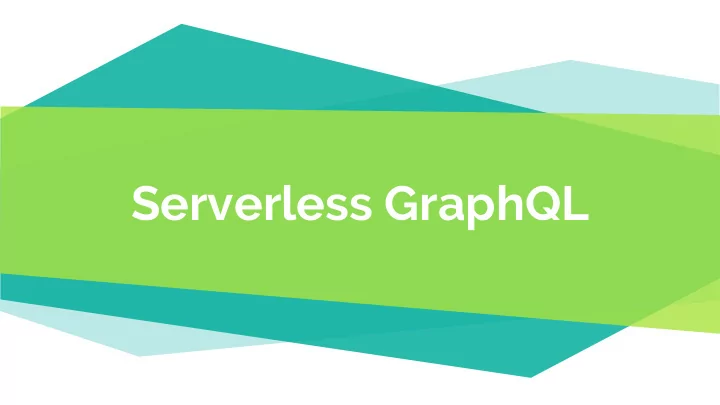

Serverless GraphQL
Howdy! I’m Jared Short Director of Innovation @ @shortjared
GraphQL A query language for your API, and a runtime for executing the queries
Why GraphQL ● One endpoint for your API ● Can provide an easy to understand API layer for your aggregated resources ● Only get the data you ask for, in the same shape ● Streamlined API iteration and extensibility ● Fantastic tooling / community
Technical Details of GraphQL ● Typed API and schema definitions ● Queries == Read, Mutations == Write ● Execution engine parses query to graph, each node runs through resolvers to fetch data ● Elegantly solves 1+n problem
Understanding the Schema Example Schema type Speaker { ● Explicitly define all types firstName: String! in the graph lastName: String! Define lists of types ● talks: [Talk] ● Nullable vs non nullable } (!) ● Scalars, Unions, Enums, type Talk { Inputs, etc speakers: [Speaker!] startTime: Int! endTime: Int title: String! TLDR room: String! GraphQL Schema Cheat Sheet }
Understanding Root Resolvers Query / Mutation Root ● Queries and type QueryRoot { mutations speakers(limit: Int = 10): [Speaker] talks(sort: ASCENDING): [Talk] available at the } “ root ” ● Accept arguments input TalkInput { title: String! for scalars or input Speakers: [ID!]! types, return types } type MutationRoot { createTalk(talk: TalkInput): Talk }
Understanding Root Resolvers type QueryRoot { speakers(limit: Int = 10): [Speaker] talks(sort: ASCENDING): [Talk] } QueryRoot: { speakers(root, args, context){ return new SpeakerService(context).loadSpeakers(args.limit); }, talks(root, args, context){ Return new TalkService(context).loadTalks(args.sort); } }
Understanding Field Resolvers type Speaker { firstName: String! lastName: String! talks: [Talk] } Speaker: { talks(root, args, context){ Return new TalkService(context).loadByIds(root.talkIds); } }
A Thin Wrapper on Business Logic ● GraphQL is NOT your business logic layer ● As thin as possible on top of your business logic ● You can map to multiple data sources ○ Rest API, Database, Filestore, etc
Developer Client Experience ● Ask for and receive exactly what you want, how you want it ● Limited API versioning concerns ● Easy to write efficient network requests ● API introspection (GraphiQL)
Developer Client Experience ● Ask for and receive exactly what you want, how you want it ● Limited API versioning concerns ● Easy to write efficient network requests ● API introspection (GraphiQL)
Serverless
Serverless? ● Still run on servers, you just don’t care ● Moves your responsibility higher up the stack ● Billing at ms increments ( micropayments! ) ● Pairs very well with event driven models
Why Serverless ● Reduced complexity of scaling ● High availability ● Economics / Total Cost of Ownership ● Rapid iteration, learn fast
Developer Hints ● Your Functions as a Service (FaaS) provider should be irrelevant ● Rethink traditional requirements and approaches ● Can it be event driven?
Serverless GraphQL
Why Serverless GraphQL ● All the normal serverless wins (scalability, availability, etc) ● All the power of GraphQL for clients and systems ● Smooth out some rough edges of GraphQL ○ Resource Exhaustion Attacks ○ Complex Resolvers
Resource Exhaustion Attacks ● Think DoS attack that’s easy to do by mistake ● Deeply nested request / pagination abuse ● Useful Optimization & Prevention ○ Enforce pagination & limits ○ Maximum depth checking ○ Request Batching & Caching
Resource Exhaustion Attacks REQUEST RESPONSE
REA Mitigation (The Easy Way) ● Each graphql execution is allocated its own resources ● Set a reasonable resource allocation & timeout ● Web Application Firewalls to stop bad actors
Request Batching & Caching Example Query Query Metrics query { 179 Speakers & 130 Talks ● Fresh cache for each speakers { invocation No Cache or Batching firstName Requests: 359 talks { ● Hard part abstracted title away from devs Cache Only / Batch Only speakers { ● DataLoader Requests: 132 / 3 firstName } https://github.com Cache & Batching } /facebook/dataloader Requests: 2 } }
Complex Resolvers & Multi-Data Sources ● Multiple data sources and aggregation made easy ● More expensive queries, split to different lambda
Schema Stitching Souce: https://dev-blog.apollodata.com/graphql-schema-stitching-8af23354ac37
Schema Stitching REQUEST RESPONSE Souce: https://dev-blog.apollodata.com/graphql-schema-stitching-8af23354ac37
Schema Stitching Souce: https://dev-blog.apollodata.com/graphql-schema-stitching-8af23354ac37
Schema Stitching with Links REQUEST RESPONSE Souce: https://dev-blog.apollodata.com/graphql-schema-stitching-8af23354ac37
Schema Stitching So What ● Still a newer concept and area in GraphQL ● Keep thinking in microservices ● Easily extend and add functionality to your services ● Composable services and products ○ Encourage reuse of services ○ Compose services into whole new offerings
A word of warning….
Don’t be that person...
When not to use (force) it ● Non-problem rarely used legacy system ● Big data exports (async returns is fine) ● Internal buy in is key, if inertia is strongly against you, don’t force it, start small ● You can sneakily integrate downstream without forcing them to migrate
Protect Downstream Systems ● You are only as strong as your weakest resources ● Serverless scales, your dependencies don’t ● Queues, caching, play nice
Back to Basics ● Authorization ● Pagination (relay spec) ● Good documentation
Getting Started GraphQL Dan Schafer - GraphQL at Facebook Talk (Pagination & Auth discussed) (via YouTube) Apollo Stack - http://dev.apollodata.com/ GraphQL Schema Cheat Sheet Serverless GraphQL Boilerplate Starter: https://github.com/serverless/serverless-graphql Graphcool Hybrid Faas Framework & GraphQL engine: https://www.graph.cool/ - Open Source with SaaS Offerings
Thanks! Questions? @shortjared
Recommend
More recommend